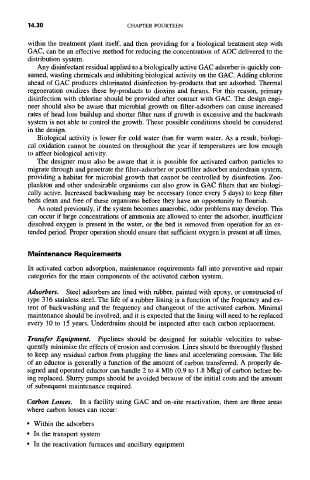Page 482 -
P. 482
14.30 CHAPTER FOURTEEN
within the treatment plant itself, and then providing for a biological treatment step with
GAC, can be an effective method for reducing the concentration of AOC delivered to the
distribution system.
Any disinfectant residual applied to a biologically active GAC adsorber is quickly con-
sumed, wasting chemicals and inhibiting biological activity on the GAC. Adding chlorine
ahead of GAC produces chlorinated disinfection by-products that are adsorbed. Thermal
regeneration oxidizes these by-products to dioxins and furans. For this reason, primary
disinfection with chlorine should be provided after contact with GAC. The design engi-
neer should also be aware that microbial growth on filter-adsorbers can cause increased
rates of head loss buildup and shorter filter runs if growth is excessive and the backwash
system is not able to control the growth. These possible conditions should be considered
in the design.
Biological activity is lower for cold water than for warm water. As a result, biologi-
cal oxidation cannot be counted on throughout the year if temperatures are low enough
to affect biological activity.
The designer must also be aware that it is possible for activated carbon particles to
migrate through and penetrate the filter-adsorber or postfilter adsorber underdrain system,
providing a habitat for microbial growth that cannot be controlled by disinfection. Zoo-
plankton and other undesirable organisms can also grow in GAC filters that are biologi-
cally active. Increased backwashing may be necessary (once every 5 days) to keep filter
beds clean and free of these organisms before they have an opportunity to flourish.
As noted previously, if the system becomes anaerobic, odor problems may develop. This
can occur if large concentrations of ammonia are allowed to enter the adsorber, insufficient
dissolved oxygen is present in the water, or the bed is removed from operation for an ex-
tended period. Proper operation should ensure that sufficient oxygen is present at all times.
Maintenance Requirements
In activated carbon adsorption, maintenance requirements fall into preventive and repair
categories for the main components of the activated carbon system.
Adsorbers. Steel adsorbers are lined with rubber, painted with epoxy, or constructed of
type 316 stainless steel. The life of a rubber lining is a function of the frequency and ex-
tent of backwashing and the frequency and changeout of the activated carbon. Minimal
maintenance should be involved, and it is expected that the lining will need to be replaced
every 10 to 15 years. Underdrains should be inspected after each carbon replacement.
Transfer Equipment. Pipelines should be designed for suitable velocities to subse-
quently minimize the effects of erosion and corrosion. Lines should be thoroughly flushed
to keep any residual carbon from plugging the lines and accelerating corrosion. The life
of an eductor is generally a function of the amount of carbon transferred. A properly de-
signed and operated eductor can handle 2 to 4 Mlb (0.9 to 1.8 Mkg) of carbon before be-
ing replaced. Slurry pumps should be avoided because of the initial costs and the amount
of subsequent maintenance required.
Carbon Losses. In a facility using GAC and on-site reactivation, there are three areas
where carbon losses can occur:
• Within the adsorbers
• In the transport system
• In the reactivation furnaces and ancillary equipment

